If you say “personal jet” in the lobby of a typical general aviation FBO, images of a Cessna Mustang, Eclipse 500, or maybe the up-and-coming Cirrus Vision will come to most people’s minds. Forget those people. Let’s talk really personal—we’re not just general aviation, we’re Experimental aviation! How about a single-seat cocoon with one jet engine and an unrestricted view out front—now that is personal. And where can you find that formula? In the new SubSonex from Sonex Aircraft, LLC. This single-engine Experimental jet features a reliable, easy-to-install powerplant, and the factory is already shipping ultra-quickbuild kits to customers.
The SubSonex began as a dream in the mind of Sonex founder John Monnett—a dream for a personal sport jet that could be flown by someone with average to good pilot talent and skill. The SubSonex JSX-1 flew as a proof of concept airplane several years ago, and astounded the community as the first such design since the BD-5J. Monnett took what he learned from the fixed-gear JSX-1 and refined the design to produce the JSX-2—the current design. An airplane with up to two hours’ endurance, it is not just an airshow performance wonder; it is a practical, fun machine that provides enough margin (in fuel, speed, structure, and forgiving flying qualities) that the dream of a true personal jet is now in reach of anyone that can afford to build a mid-level homebuilt. You wouldn’t want to make it your only transportation machine, or a “daily driver/do-all” plane—but as a way to unwind in the sky, it would certainly fill the bill.
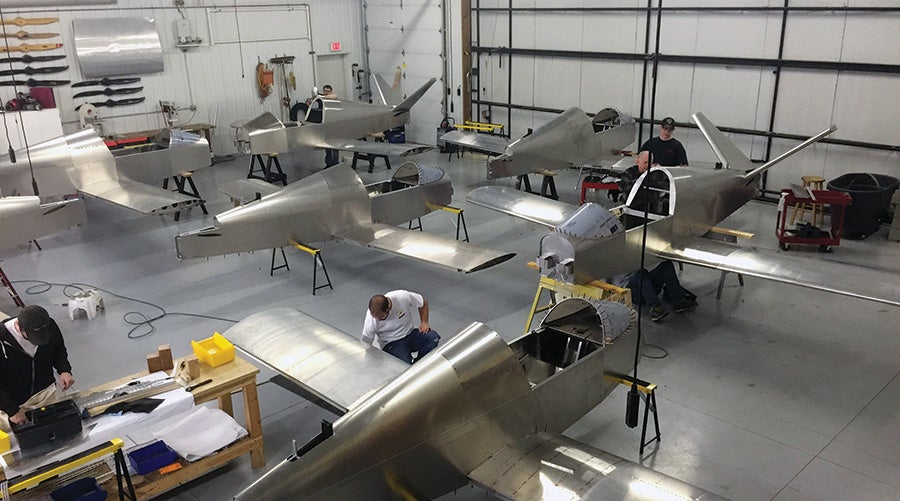
SubSonex quickbuild kits under construction in Sonex’s Oshkosh facility. Despite the cach of being a jet, the construction is familiar to anyone who has built a Sonex.
KITPLANES was given the opportunity to be the first independent organization to fly the jet for an evaluation, so in April we headed down to Moriarty, New Mexico, the home of test pilot Bob Carlton’s Desert Aerospace, to complete the necessary transition training and give the little jet a workout. The training program devised by Carlton and Sonex (and approved by the FAA) is thorough, yet not complicated, and prepares one well for their first flight in the jet (see sidebar on page 21). The airplane flown for the test was the JSX-2 prototype, currently on tour with Carlton flying airshow routines for aviation fans around the country. For a prototype, we were impressed with its fit and finish, and while a few improvements are still in the works, it is representative of what the first customers are building in workshops right now.
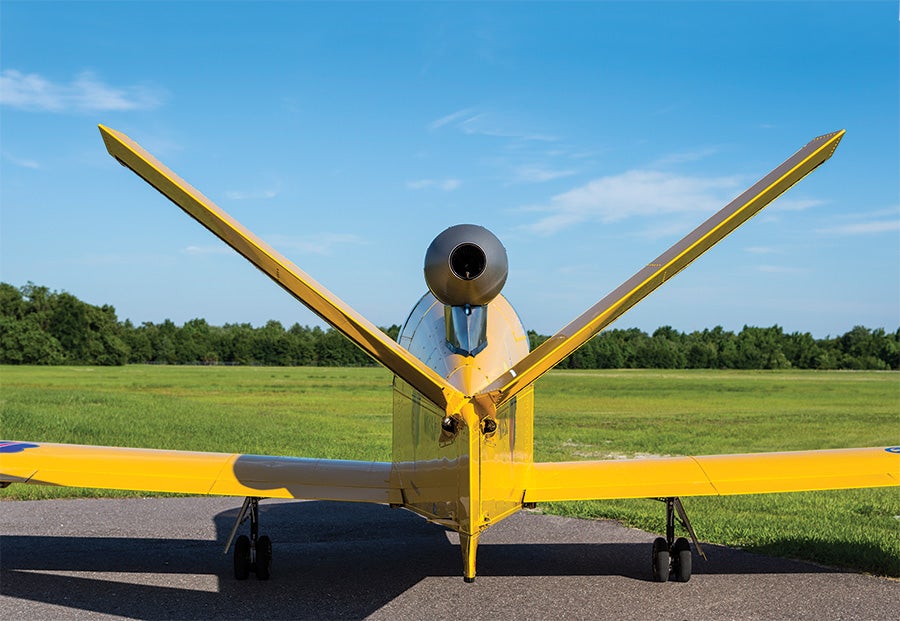
The Y-tail is the perfect configuration for a single-engine jet. The high thrust line is noticeable, but easily managed.
Construction
Structurally, the SubSonex appears to have a great deal in common with its piston-powered Sonex brethren. The all-aluminum structure is conventional in every way. Pop rivets are used for primary assemblies, and I saw few cases where solid rivets were used or required. Most of the aluminum panels are flat or have a single curvature—very few compound curves were evident, and if they were, I expect that those parts are pre-formed by Sonex. The basic box structure includes aluminum angles at the corners, with flat panels such as the side and bottom riveted to those to provide a rigid cocoon.
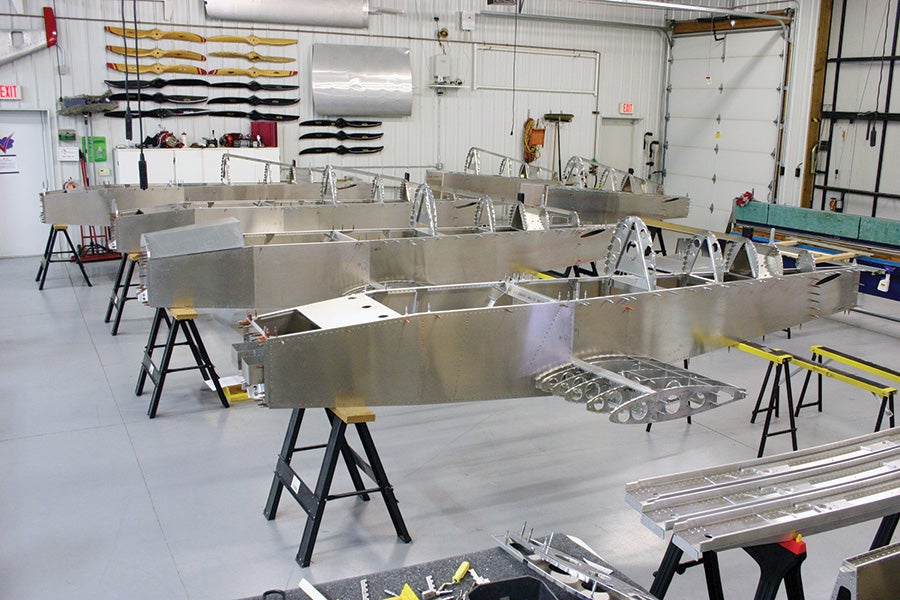
The simple box-like construction might almost make a builder wish there was a non-quickbuild option.
The outer wing panels are removable for transport (and Sonex offers a trailer that is custom-configured to transport the jet). Since there is no fuel in the wings, putting the airplane together and taking it apart is fairly simple. The fuel tank is poly and sits in the fuselage behind the pilot. The “Y-tail” (two ruddervators and a small rudder that forms the stem of the “Y”) appears to be built just the same as the tails on the Waiex and Xenos—proven designs from Sonex. This tail works perfectly for the SubSonex, as the jet exhaust goes right between the panels.
The landing gear on the SubSonex has got to be one of the smallest set of retractable wheels I have ever seen on a human-carrying airplane. Ingeniously designed by John Monnett, the gear features two wheels on each maingear truck and a single wheel on the steerable nosegear. While many (if not most) new tricycle-gear aircraft are electing to go with free-castering nosewheels and differential braking for steering, Monnett decided that a single brake master cylinder was lighter than two, and that steering the nosewheel was a lighter alternative. The result is an airplane that steers just fine at all speeds from a slow taxi to the 90+ mph rotation.
The brakes are custom-built into the mainstruts and actuate on disks on one wheel on each side. We understand that a design change to include a brake on the other wheel is in the works; this should increase the available braking capability quite nicely.
The gear is retracted and extended via a pneumatic system that includes an air pump behind the pilot and very small air lines running down to each wheelwell. The gear goes up and down fairly quickly when the pilot throws the toggle switch on the panel. Three green LEDs indicate that the gear is down and locked, and three red ones indicate that it is retracted. A small pressure gauge located behind the pilot’s head indicates the pressure in the system; it is viewable in flight, but not part of the normal scan. It is checked only if the pilot suspects a problem. The LEDs can be a little tough to see in direct sunlight, but you quickly learn to shade the indicator panel with your hand when checking that the gear is down.
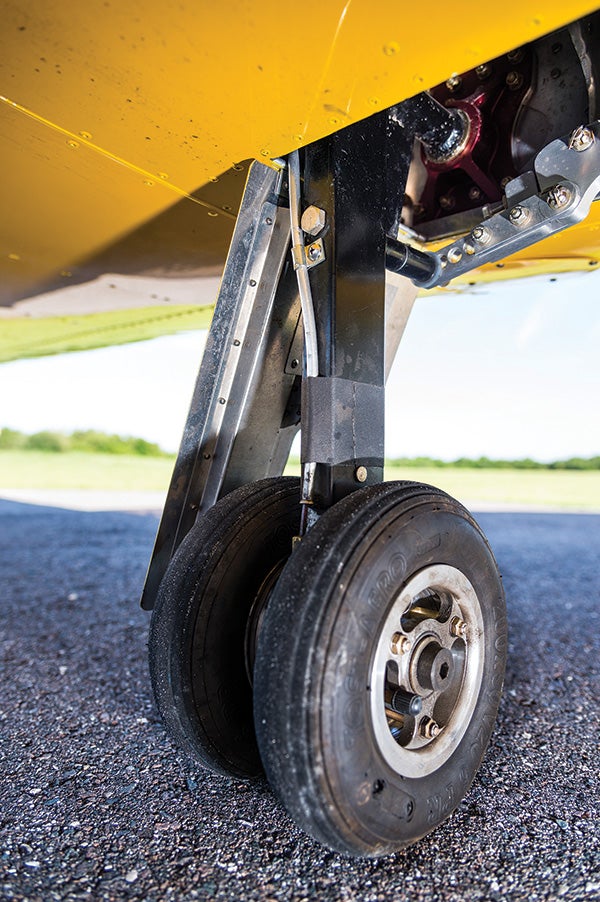
The maingear features two tires per side—just like the space shuttle. To improve stopping power, John Monnett has a new design in the works for the brake system.
A small camera (actually an automotive backup camera) is installed on the underside of the nose, looking backward. The image can be displayed on the EFIS screen if desired to make sure that the gear is actually extended. This is a good backup to the green LEDs, but we never had to use it in flight.
The top-mounted engine is attached structurally with two bolts. This allows for easy maintenance and a simple load path. The canopy is a tip-over and in the current kits is pre-fitted and ready to go—a huge time-saver for most everyone. In the cockpit, plastic side panels close out the mechanisms for controls on each side and make for a comfortable environment for the pilot. The large single-screen MGL EFIS is in easy reach, and its position is excellent for viewing.
All in all, a builder will find that the SubSonex is conventional and much simpler to build than a typical homebuilt because there are no engine baffles to fit and build, the powerplant systems themselves are so simple as to be mostly hooking up connectors, and the most complex wiring will probably be for avionics—and if you go with the factory setup, that is mostly plug and play as well.
In the Cockpit
The SubSonex cockpit is comfortable for this average-sized human (5 feet 8 inches, 170 pounds). Bob Carlton, the factory test pilot, is three inches taller, and reports not feeling cramped. Comparing it to other single-seat aircraft, I felt it was a little wider than the RV-3 or Onex, and about the same as the newer Panther. Sonex provides plastic side panels in the kit—an unusual luxury item for small homebuilts—and yet these don’t intrude on the usable space. You’re not going to play handball in the cockpit, but I suspect that most pilots won’t feel crowded.
Once you settle yourself in, the first thing you might notice is the lack of a stick between your legs. The SubSonex departs from traditional Sonex designs by having a side-stick controller on the right side. There is a nice rest to stabilize your forearm, and the overall system is quite comfortable.
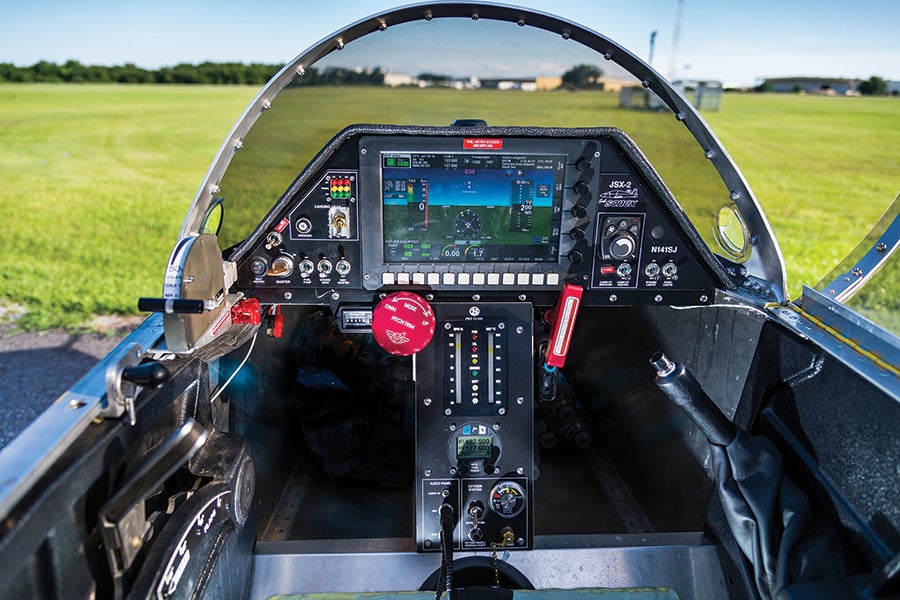
The SubSonex panel is dominated by a single EFIS screen. Very few switches are required for the rest of the plane’s operation. The engine monitoring panel is in the center console.
On the left side is a hefty handle with detents and a safety latch. Pulling back on the handle increases flap deflection, and pulling all the way back activates the brakes. As with all Sonex designs, there is no differential braking. The safety latch on the handle must be squeezed to move the lever out of the flaps-up position.
While the left hand falls naturally to the combo lever, that’s not the throttle. The throttle is actually a fairly small handle on a quadrant mounted up near the canopy sill. This quadrant is the standard controller provided with the PBS TJ-100 turbojet engine, and includes a spring-loaded idle stop. The engine is started by moving the throttle through the spin-up positions, then popping it past flight idle.
The canopy latch is located behind the throttle, and is a little stiff—but this is a good thing because you sure wouldn’t want to accidentally release the swing-over canopy in flight. In addition, the latch has a safety pin that is inserted after closing to make sure that it won’t be moved accidentaly.
Moving across the front panel, you’ll find remarkably few controls for a turbine aircraft. The landing gear switch and indicator lights are in the upper left of the panel. This switch controls the pneumatic gear. The pilot will occasionally hear the air pump cycle to maintain system pressure. Beneath the gear switch are the master, fuel pump, engine main power, and instrument master switches. The large MGL screen dominates the middle of the panel, and on the right, you find a controller for a cabin heater (not yet installed in this aircraft) and switches for strobes and position lights. A push-to-talk switch sits atop the sidestick.
The center console includes the standard red Sonex trim wheel, the 2 -inch MGL com radio, controls for the oxygen system, and—most importantly—the display module for the engine. This module shows rpm and EGT on vertical light bar displays, as well as status lights for the engine, oil pressure, generator, and the automatic protection system. On the right side of the center console, you’ll find a big red T-handle for the Ballistic Recovery ‘chute and the Mountain High oxygen system outlet.
Everything you need and nothing that you don’t—that’s the theme in the SubSonex. It is, after all, a day VFR airplane (at this time), and that simplifies a lot. The FAA is still trying to get its collective heads wrapped around the idea of a jet aircraft that doesn’t normally fly IFR, but frankly, this airplane is plenty of fun to have around without trying to burden it that way. In any case, the SubSonex hasn’t been used for cross-country flight yet, and until that need arises, the cockpit is perfect for what it does.
Sitting in the cockpit, it feels like you can almost reach out and touch the wingtips, but the little cocoon feels quite substantial and compact, not at all flimsy, and ready to go flying!
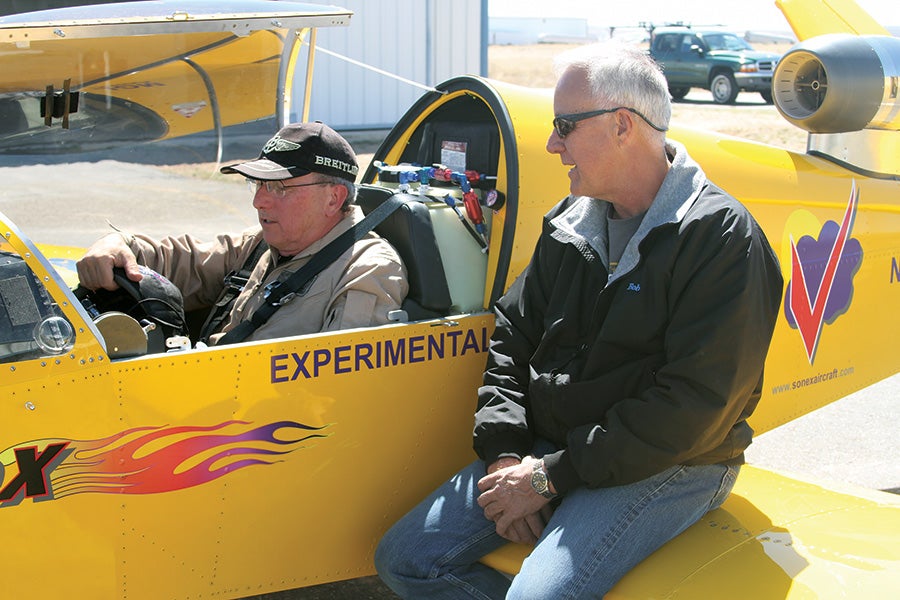
After his first flight in the SubSonex, the author (left) is debriefed by test pilot Bob Carlton. First impressions? The jet is fun and not difficult to fly!
Flying the SubSonex
The SubSonex is an interesting mix of complexity and simplicity. On the one hand, we all know that jets require careful attention to procedures, precise speed control, and measured responses to off-nominal situations. On the other hand, the SubSonex is started with a single move of the throttle lever, the cockpit has very few switches, and the construction is typical Sonex—simplicity personified. There is nothing truly complicated about the SubSonex. In fact, pilots just figure that there must be a catch because it is a jet. Allow me to let you in on a little secret: If you are reasonably sharp enough to handle anything more complex than a basic trainer, you can probably learn to handle this machine.
Getting into the airplane requires a little help. Because of its size and the placement of the landing gear, it will sit on its tail with no one in the cockpit. While it is OK for it to sit on the tailskid, it is not OK for it to bang on the skid, so it is important to counterbalance the plane by having someone push down on the nose while the pilot enters. Current operating technique includes three lead-filled shot bags placed in the leg wells to hold the nose down when no one is aboard. These get removed when the assistant pushes down for the pilot to enter.
Once I stepped over the cockpit sill and slid my legs in place, it was apparent that the cockpit has ample room for more than just an average-sized human. Fastening the five-point harness was easy, and since the current airplane is used for aerobatic routines at airshows, it is equipped with a secondary safety belt which we also fastened—it was there, so why not use it. Once harnessed in, there was plenty of room to swing my head around to see the pneumatic pressure gauge behind my head (which does not need to be monitored routinely). Visibility in all directions except straight back was excellent, and controls fell easily to hand.
The prestart routine involves powering up the MGL EFIS, setting the altimeter, and preparing to record data (if required). One unique step is to bring up a video window to have a look at a nose camera that looks back at all three landing gear—a backup to the gear position lights. Additional preflight tasks include setting the fuel computer with the current quantity, checking the battery voltage, and setting the parking brake for the start. The large combined flap and brake lever on the left side currently has a few pinch points, but I was told that the design has already been changed to allow more room for larger hands.
The start sequence begins when you power up engine electronics and check the display with the lamp test feature. Next comes the fuel pumps and a check to make sure the pressure comes up above 4.0 psi. The start is accomplished by advancing the throttle from the stop position to the first detent—there you can hear the separator spooling up. After about two seconds, the voltage stabilizes, and you go one more notch to the slow-spin position—you can then hear the compressor beginning to turn. Again, the voltage stabilizes and you go to the high-spin position, then when a few more seconds have elapsed, you depress the flight idle plunger and advance the throttle to the 50% position—ignition kicks off shortly, and the pilot monitors voltage, fuel flow, and EGT to make sure the computer does everything properly.
Procedures call for one to two minutes of engine warmup, and if you have already latched the canopy and are ready to go, you can advance the throttle to break away and begin rolling for the runway. It takes a fair amount of throttle to get rolling—then you want to retard it right away to flight idle to prevent rampant acceleration. Speed is modulated by pulling back on the brake handle. Braking effectiveness is a bit limited on this particular airplane, and Sonex knows this; they are already working on brake modifications, which should make speed control while taxiing much easier.
Once you have completed the start sequence and are rolling toward the runway, you’ll find there is remarkably little left to do before takeoff. Check the flight controls one more time, scan for traffic, disable limit monitoring for the engine (to prevent a potential automatic shutdown at a bad time), and as you roll onto the runway, slide the brake/flap handle all the way forward, steering onto the centerline with your feet. Advance the throttle smoothly to about 90%, let it stabilize as the airplane accelerates, advance it to full power, and watch the airspeed climb—quickly!
The tiny wheels are up to the job of supporting this airplane, but as you reach rotation speed of about 90 mph, you might wonder how much more they can take. The answer is plenty, but they get sounding pretty frenetic as you ease back on the stick. Easing is important to prevent over-rotation, and patience is rewarded with a smooth liftoff and acceleration. The intensifying wheel rumble beneath you is a good cue that it’s time to lift off, and as it goes away, an equally good cue to throw the switch to retract the gear. The three green lights go out, the sound of the gear in motion comes and goes, and the three red gear-up lights come on—just about the time you accelerate past gear retraction speed and start really covering ground.
160 mph is a good speed for climb, giving a nice rate and good penetration at the same time. Jet engines produce more power the faster they go, so speed is important for a good climb. I found that if I flew a reasonable pattern at 160, by the time I was on crosswind I was nearly 1500 feet above the airport—well clear of traffic and headed to the practice area. This procedure was with the engine throttled back to 92% (maximum continuous power) once above 300 feet agl. Pitch stability in the climb was good, with fairly light forces. I was advised to keep the trim full nose up during climb, primarily because the spring bias system doesn’t add much force, and the sensitive pitch channel requires little force to hold speed. This actually worked quite well, and I found no hunting or instability across a wide speed range. It is not strongly stable however—but this really helps you point it wherever you want to go—including up!
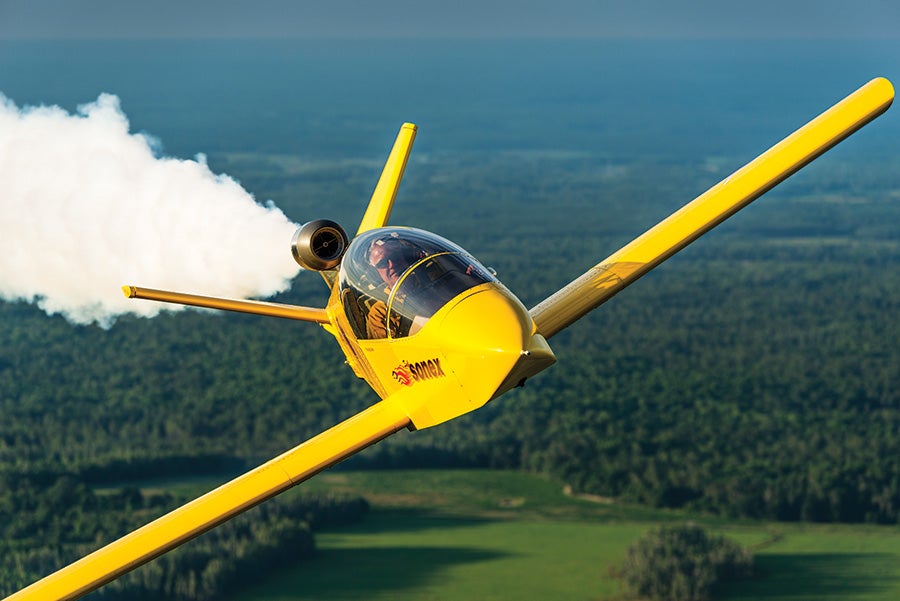
With no room for a standard smoke tank, Carlton designed a conformal fiberglass container that fits in place of the seat cushions for airshow work. It is quickly removable for normal flying.
Once level in the practice area, my first task was to do some 360 turns, first with 30 of bank, then at 45—and then increasing that to 60. Once I got over 45, opposite aileron was required to keep the bank from steepening—something the SubSonex shares with most constant-chord, low-aspect ratio wings. There was plenty of control authority to keep the airplane tracking in roll and yaw, and little effort was required to maintain altitude. Sitting well up front, with little beyond your feet for reference, it pays to frequently glance at the attitude indicator on the primary flight display (PFD) to make sure you aren’t gaining or losing altitude.
Rolling out on a heading was a piece of cake (the smooth morning air making it even easier), but even the afternoon bumps didn’t make the task difficult. With the area cleared of traffic by steep turns, I slowed the airplane down to see how it stalled. Power on, power off, clean, or dirty—the stall was not a problem. This is not a swept-wing fighter, and the behavior was again very much what you would expect from a short-wing sport plane. There is no real rolling torque applied to the airplane at slow speeds, and while it did tend to fall off on a wing at the buffet, it seemed random whether it would go right or left. Recovery was simple and straightforward, with little loss of altitude. Deep stalls and spins were not on the agenda, and we understand that spins are on the test plan in the near future, so there was no need for us to rush the process.
For now, we felt it was prudent to leave the aerobatics to airshow performer and SubSonex test pilot Bob Carlton, although a few mild lazy eights showed no uncivilized habits. It would have been nice to stay up in the clear New Mexico sky all day—but there were landings to be evaluated and I was burning fuel, so it was time to start a descent and head for the runway. Preflight briefing emphasized a stabilized approach from a reasonably sized pattern, so I planned a wide downwind entry and got the speed down below 125 as soon as I was established. This is the current gear extension speed, so once leveled off, I threw the switch and the noise level increased as the wheels stuck out into the airflow. Three green lights rapidly appeared—a welcome sight on any first evaluation flight.
Pattern operations are fairly simple: Make sure the gear is extended on downwind and disable the automatic protection for the engine (this means turn the PDB on and verify the red light). Drop one notch of flaps at low key, abeam the touchdown point. Slow to about 110 and set power as required to maintain a nice glide path to the runway. Fly the pattern wider than you would for your typical short-wing sport plane—this is not an RV, and you don’t want to be dropping in from a high, steep approach. Jets like nice, stabilized approaches that give you plenty of time to get the speed and power right. I tried for about a mile on final for my approaches; clearly, with experience, this can be shortened up a bit.
Glideslope control is important—you don’t get instant power response from the jet. Although the lag is not terrible, it is noticeable, so any deviation where you think you are going low needs to be corrected right away. If you find yourself chasing the throttle back and forth, it is probably a good sign that your approach is not stable, and a go-around would be appropriate. Too much speed is also going to be a problem; the airplane just won’t slow down since there is always that residual thrust that you can’t get rid of. There’s no big constant-speed prop to act as a speed brake here—just smooth power. I slowed to 100 mph on base and pulled on another notch of flaps to add drag, then brought it down to 95 mph on final; this gave me a good feel between too fast and too slow, with a little extra energy if I needed it.
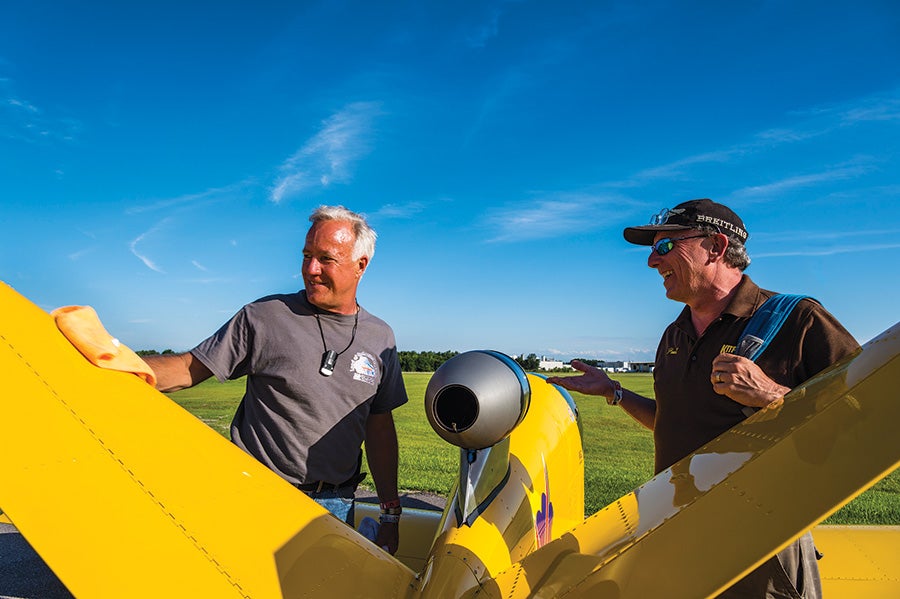
Smiles seem to be one constant among those who have flown the SubSonex. Carlton (left) and Dye find it hard to stop grinning when talking about the jet.
Pilots are cautioned that if they don’t like what they see on approach, a go-around decision should be made early—not just inches off the pavement. It takes several seconds to get enough thrust out of the engine to arrest the sink rate and establish a climb, and the effects of the top-mounted engine is a downward-pitching moment when it really gets going. There is plenty of control authority to handle the pitch-down, but it can be a surprise the first time around, and it is best handled with a little altitude between you and the pavement. I performed a go-around early in the evaluation flights, just to experience the effect, and once I’d felt it, became comfortable with what is required. It’s really a characteristic of the configuration rather than a fault—but it does mean that you need to stay ahead of the airplane (as with all high-performance singles).
Crossing the threshold at 85 mph seemed about right to minimize float, and then it was just a matter of feeling for the runway in a very low-slung airplane. Keep on flying it after you think you should have touched down—you are probably still a foot in the air (unless you are used to flying tiny gliders). The touchdown itself was generally smooth, with no hint of bounce. The nose came down on its own almost immediately, and then it was up to the brakes. Make sure that the throttle is at idle; there’s no need to add any more energy into the equation.
The current flap/brake lever is a bit tight for even an average-sized hand, but with a little practice, you can get your pinky on the safety catch and pull back with the whole hand to get brakes. Keep on braking because this is going to take a while. John Monnett has a design for a separate brake lever in the works, and this should make things much better. But for now, a longish runway is desirable. Touching down on speed makes a big difference as well, of course—on slower landings I used a lot less pavement to get stopped. If you’re still rolling, keep braking! It’ll stop. Bob O’Haver, the Designated Pilot Examiner (DPE) authorized to issue ratings for the airplane, suggested pumping the brake handle, and this worked better on my last flight. Steer with the rudder pedals, and no, pushing on them harder won’t make you stop any quicker—they are just rudder pedals, not brakes! When you feel that you can make a nice 90 turn, go ahead and turn off the runway, then taxi with your hand on the brake lever and the throttle at idle. Thought you were done braking, huh? Nope—not until you get to the hangar!
Shutdown is as simple as the start: push the detent button in and slide the lever to the stop position and listen to it spool down. The control unit will keep motoring the engine two minutes more for cooling, so expect to hear it continue to turn. When the spinning stops, you can power down the rest of the airplane according to the checklist. Stop any recording on the EFIS, turn the master off, and you’re done. You can open the canopy while the engine is cooling down, a recommended practice in New Mexico, even in the early spring; that big piece of Plexi collects a lot of heat!
Lasting Impressions
The SubSonex is not a hard airplane to fly at all—just different in a few ways. You need to have some speed to get a good climb, and you need to be aware of the time it takes to spool up the engine on approach in case you find yourself low. A shallow approach can be nice and stabilized.
Slow flight in the airplane is comfortable because this jet actually has some wing; I have flown many homebuilts with bad stall characteristics, but this is not one of them. Because you are sitting ahead of the wing, and there is very little ahead of you, sight references for turns and other maneuvers are sparse—a quick glance at the attitude on the screen is a good idea.
It would be nice if the MGL EFIS had a velocity vector (flight path indicator) like other systems; this is generally the quickest way I know to make sure you aren’t climbing or diving when sight references fail you. Nevertheless, I was able to make my way through a couple of 60 banked turns in some pretty good bumps while keeping the altitude plus or minus 100 feet.
The main areas of improvement are already being worked on by Sonex. Beefier brakes and a modified brake handle will make ground handling and rollout more comfortable. You couldn’t ask for simpler systems operations: the engine is on, off, or throttled. There’s no mixture to monitor or prop pitch to play with. The design is pretty mature, and while I am sure there will be additional changes as more pilots finish their ships and begin to fly them, I would be happy to fly the current airplane regularly if I had one available. For those Sonex customers receiving the first few SubSonex kits—you’ve got a lot of fun ahead of you.

![]()
Paul Dye retired as a Lead Flight Director for NASA’s Human Space Flight program, with 40 years of aerospace experience on everything from Cubs to the space shuttle. An avid homebuilder, he began flying and working on airplanes as a teen, and has experience with a wide range of construction techniques and materials. He flies an RV-8 that he built in 2005, and an RV-3 that he built with his pilot wife. Currently, they are building a Xenos motorglider. A commercially licensed pilot, he has logged over 4800 hours in many different types of aircraft. He consults and collaborates in aerospace operations and flight-testing projects across the country.

































